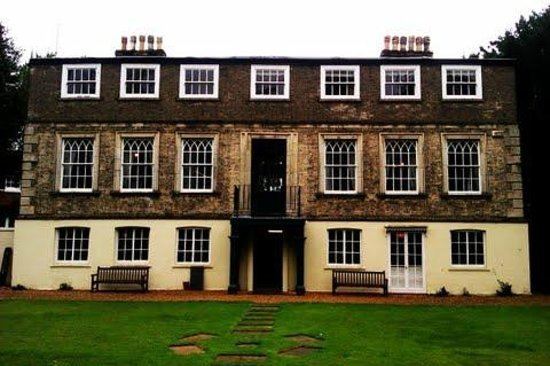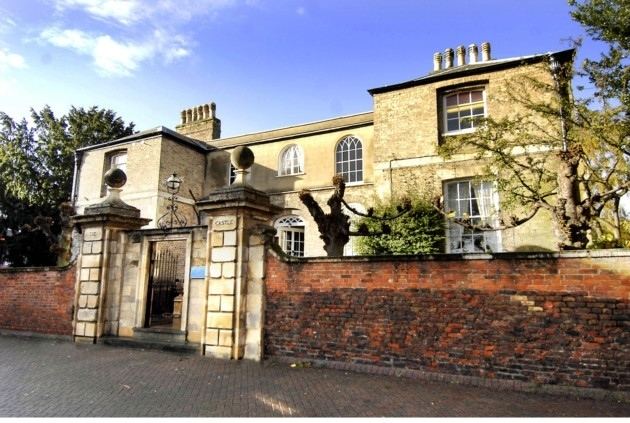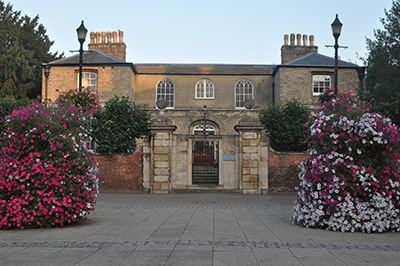 | ||
Similar Fenland and West Norfolk A, Wisbech & Fenland Museum, Peckover House and Garden, Clarkson Memorial, Our Lady & Saint Charles B | ||
Wisbech castle
Wisbech castle was a motte-and-bailey castle built to fortify Wisbech, in the Fenland area of Cambridgeshire, England by William I in 1072. The Norman castle, reputedly was destroyed during a devastating flood of 1236, the original design and layout is still unknown. In the 15th century repairs were becoming too much for the ageing structure, and it was decided to create a new building, starting in 1478 under Bishop Morton of Ely (later Archbishop of Canterbury and Chancellor of England). His successor, Bishop Alcock, extended and completed the re-building and died in the Castle in 1500. Subsequent bishops also spent considerable sums on this new palace. The Bishop's Palace was built of brick with dressings of Ketton Stone, but its exact location is unknown.
Contents

In later Tudor times the rebuilt castle became a notorious prison. The site was again redeveloped in the mid-17th century and yet again in 1816 by Joseph Medworth. A 1794 plan of the 'castle' exists, this only shows the 'castle' as it existed at the end of the 18th century, prior to the development of the site to its current form.

Table tipping at wisbech castle 17 10 2013
History

In the last years of the 16th century there were 33 English Catholics held prisoner in Wisbech Castle, almost all of them priests, including the Jesuit priests, Christopher Holywood, William Weston and lay brother Thomas Pounde. A quarrel arose among them that came to be known as the "Wisbech Stirs". In the winter of 1594-95 a substantial group (18 of the 33) wished to separate themselves from the rest and adopt a regular communal life. This was largely impossible without appearing to castigate those who did not want to make this change and on account of the limited space. The unwilling minority argued, which only confirmed the others in their resolve, and the separation was carried out in February 1595, but came to an end with a general reconciliation in November of that same year. Philip Strangeways was one of the missionary priests imprisoned at Wisbech at the end of Elizabeth's reign. Other leading Roman Catholics were imprisoned for political reasons, at the time of the Spanish Armada; Robert Catesby and Francis Tresham were also held at Wisbech. Later they were to become the principal conspirators in the 'Gunpowder Plot'. The use of the castle for recusant prisoners ceased in 1627.

The present regency villa formed the centre of a major redevelopment of the area in 1816, ensuring that the site has been continuously inhabited for nearly a thousand years.

The building is owned and operated by Cambridgeshire County Council and used as a Professional Development Centre, providing a venue for meetings and training. School visits also take place and the property is licensed for Civil Weddings.

In recent years the Castle has been used as a location for television and film drama. The BBC's David Copperfield and Atlantic Films, Dean Spanley both utilised the building and the Crescent for parts of their productions.
In September 2009 excavations were carried out on the site by Oxford Archaeology East and local volunteers. The report was published July 2010. The Wisbech Castle Community Archaeology Project was 'Highly Commended' in the Best Community Archaeology Project category at the The 2010 British Archaeological Awards. As a result of the dig local volunteers formed a local archaeology group – the Wisbech and District Archaeology Society (WADAS) - now FenArc (Fenland Archaeology); initially meeting at the Castle before moving to Mendies.
